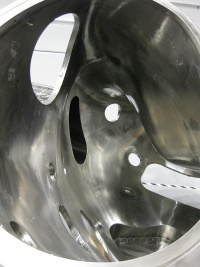Stellarator: Difference between revisions
Jump to navigation
Jump to search
No edit summary |
No edit summary |
||
| Line 2: | Line 2: | ||
[[File:NCSX_plasmaVessel.jpg|200px|thumb|right|NCSX plasma vessel.]] | [[File:NCSX_plasmaVessel.jpg|200px|thumb|right|NCSX plasma vessel.]] | ||
== Classification of stellarators == | |||
Somewhat arbitrarily, stellarators may be classified according to the type of magnetic configuration. | |||
* Torsatron / Heliotron: the [[rotational transform]] is produced by an external helical coil surrounding the plasma. | |||
* Heliac: a stellarator with a toroidally helical magnetic axis. | |||
* Helias: advanced stellarator with modular coils. | |||
== Defunct stellarators == | == Defunct stellarators == | ||
Revision as of 08:55, 9 September 2013
A stellarator is a magnetic confinement device. The rotational transform is predominantly generated by external coils - as opposed to a tokamak, in which the poloidal field is generated by plasma currents. Hybrid concepts (including the concepts known as quasi-axisymmetry and quasi-omnigeneity) employ both external coils and self-generated (bootstrap) currents (e.g. NCSX).
Classification of stellarators
Somewhat arbitrarily, stellarators may be classified according to the type of magnetic configuration.
- Torsatron / Heliotron: the rotational transform is produced by an external helical coil surrounding the plasma.
- Heliac: a stellarator with a toroidally helical magnetic axis.
- Helias: advanced stellarator with modular coils.
Defunct stellarators
- ATF (Oak Ridge, TN, USA)
- CHS (Japan)
- NCSX (Princeton, NJ, USA) - cancelled before construction was completed
- W7-AS (Garching, Germany, 1988-2002)
Operational stellarators
- CAT/CTH (Auburn, USA)
- H-1NF (Canberra, Australia)
- Heliotron-J (Kyoto, Japan)
- HSX (Madison, WI, USA)
- LHD (Toki, Japan)
- TJ-II (Madrid, Spain)
- TJ-K (Stuttgart, Germany)
- TU Heliac (Tohoku Univ., Sendai, Japan)
- UST-1 (Spain) - tabletop experiment
- WEGA (Greifswald, Germany)
Future stellarators
See also
- Stellarator reactor
- International Stellarator and Heliotron Workshop
- Coordinated Working Group Meeting
- Stellarator symmetry
- Stellarator News
- ARIES Project (conceptual design of a compact stellarator)
- Spherical Stellarator design study
References
- M. Wakatani, Stellarator and Heliotron devices, Oxford University Press, New York and Oxford (1998) ISBN 0-19-507831-4
